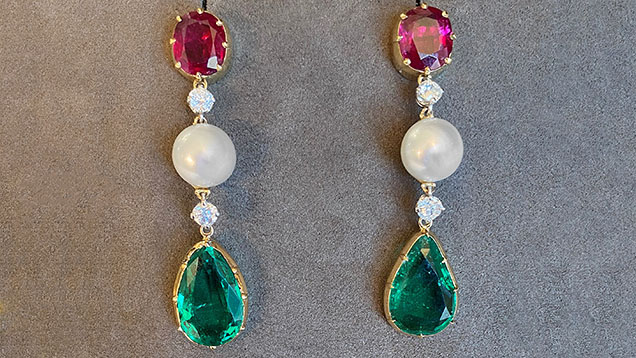Spotlight on Natural Nacreous Pearls

A natural pearl forms in the interior of a mollusk within a naturally formed pearl sac without human intervention. The use of natural pearls goes back thousands of years, and these biogenic gem materials have been treasured in jewelry and adornment throughout human history. In general, pearls can be separated into two varieties based on surface structure: nacreous and non-nacreous. The nacreous pearls are more common in the market. These are formed by a layered structure of aragonite platelets together with organic substances as well as water, and they normally display a pearly luster.
At the AGTA show, Alex Vock of ProVockative Gems Inc. (New York City) shared some of his expertise in natural saltwater nacreous pearls. With more than 30 years in the business, he is considered an industry leader specializing in signed collectible jewelry, natural gemstones, and natural pearls. He had several pieces on display, including an attractive pair of natural pearl earrings set with unheated Burmese rubies and unoiled emeralds (see above).
Vock discussed the global market for natural nacreous pearls, noting that it was greatly diminished by the 1980s due to the prevalence of cultured pearls. However, regions such as many of the Gulf countries and India did not feel pressure from the cultured pearl market. These countries have led a resurgence of natural pearl’s popularity, specifically with Basra pearls. These originate in the Arabian (Persian) Gulf, and their namesake is the city of Basra in Iraq. Historically, Basra was the center of natural pearl commerce, with the greatest selection of natural pearls and the most informed dealers.
Vock mentioned that the most prized natural nacreous pearls today are from either the Gulf region or Australia. Currently, both regions produce what dealers describe as “new material,” which are freshly harvested natural pearls. Natural pearls form in the mantle of the pearl mollusk shells, whereas cultured saltwater pearls grow inside the gonad of the mollusks. Many natural pearls have a large flat surface, similar to a button shape, because they grow against the mantle. For that reason, round, oval, and drop-shaped pearls are rarest and most valuable.
When comparing pearls from the two regions, Vock explained, there are some differences. Basra pearls usually have a warmer bodycolor, while Australian pearls tend to be whiter. Also, Basra pearls are often rounder than their Australian counterparts. In fact, the Gulf region has the highest percentage of round natural nacreous pearls of any producing area. He credited this to the smaller shell of the Gulf region mollusks.
To see Alex Vock explain these common appearances with examples from his current collection, see the video above.



